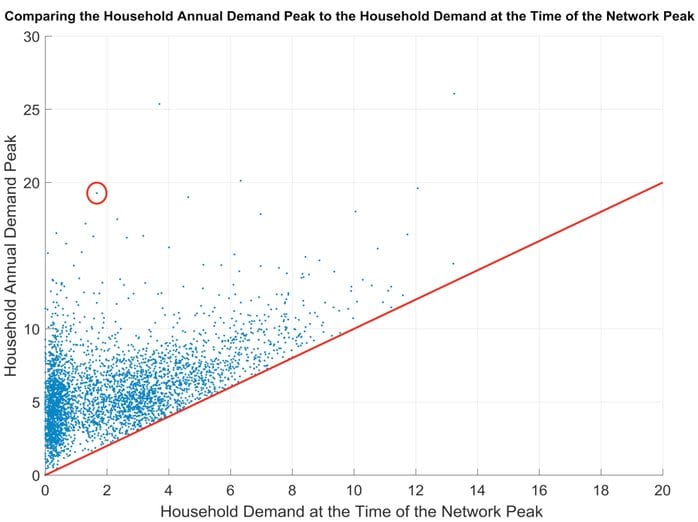The majority of the distribution network operators develop what they call ‘cost-reflective’ tariffs that charge customers based on their monthly peak demand, but it can readily be shown that this isn’t what causes the annual network peak. The annual network peak is important because it determines the possible need for network augmentation, and so determines the capital costs faced by the network.
We have analysed the load data from 3,876 households from the Smart Grid Smart City database for 2013. Their aggregated load profile, which is a proxy for the load profile of the network that serves them, peaks in summer at 6pm on Fri 18 Jan.
As shown in the chart below, about half of the houses actually peak in winter, with only 31% peaking in summer. Only peaks between 2pm and 8pm are included in this analysis because this corresponds to a common period when demand charges are applied.

The chart below then compares each household’s annual demand peak with each household’s demand at the time of the network peak (which is what causes the network peak). All the households above the red line have an annual peak that is greater than their demand during the network’s annual peak. For example, the red circled point has an annual peak of 19.3kW but was contributing only 1.7 kW during the network peak.
This means that charging a household based on their annual demand peak would not only result in them being charged too much, but would also mean they are charged for network augmentation at times when their demand is not affecting the cost of augmentation.

The network’s ‘cost-reflective’ tariffs compound this problem by applying the demand charge to the monthly peak for every weekday of the year (sometimes every day). The chart below is the same as the chart above except that instead of using each household’s annual demand peak, it uses the average of each household’s monthly peak (which is what the network’s demand charge would be applied to).
It can be seen that, in addition to most houses being charged more than they should be (generally those who are less responsible for the network peak), now some of the households (generally those who are more responsible for the network peak) would be charged less than they should be. The correlation between payment under the demand charge and responsibility for the network peak is very low, at 54%.

This has a number of important implications.
- Because the demand charge is applied through the whole year, households have a stronger incentive to install load control devices such as batteries.
- However, batteries will be programmed to shave a household’s peaks, not minimise demand at the time of the network peak, which will make them less effective at reducing the network peak. Similarly, suggestions of a ‘pipe approach’, where a household’s grid connection capacity is capped at a certain level, will be ineffective.
- Having larger networks increases the size of the network operators’ Regulated Asset Base, and under revenue cap regulation they are able to increase their tariffs to maintain their revenue.
It is clear that a more rigorous approach to ‘cost-reflective’ tariff design is required. There is also a need to allocate the sunk (residual) costs fairly, as well as design tariffs that households will wish to take up. While the AEMC’s decision to provide non-prescriptive guidelines for the setting of cost-reflective tariffs is understandable, it has resulted in the approval of network tariffs that are unlikely to be efficient or fair or voluntarily taken up by most customers.
This is an ongoing area of research for CEEM and we will soon be releasing a discussion paper on this topic.
Rob Passey is a Senior Research Associate at the Centre for Energy and Environmental Markets (CEEM) at the University of NSW, Policy Analyst at the Australian PV Institute and Senior Consultant at IT Power (Australia).
Navid Haghdadi is an (excellent) PhD Candidate at CEEM UNSW.






